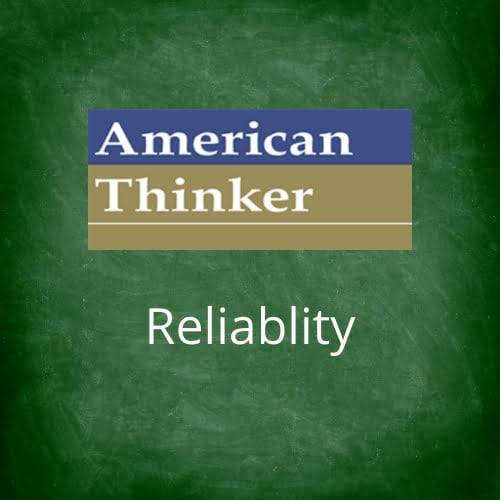
American Thinker is an online news publication composed of accomplished contributors in their fields, such as author Thomas Lifson, former attorney Ed Lasky and management consultant Richard Baehr. Despite this, the source has only gathered some attention from the public, finding themselves ranked 362nd among news and media sources in the United States. Similar Web also estimates that American Thinker receives a monthly average of 4.7 million monthly visits.
This article will seek to evaluate the accuracy and dependability of the American Thinker. Considering this somewhat lack of popularity, does the American Thinker have more incentive to push more fallacious content in hopes of gaining more attention from the public?
Does Reliability Matter?
Reliability, in general, refers to how trustworthy or accurate information, or in this case, a news source is. If we consider this definition, it quickly becomes clear why reliability is important in media sources. If we can’t trust the things we read then there isn’t much of a point in continuing to consume content from that source, after all. So how exactly can we gauge the reliability of a news source anyways?
There are several potential measures of reliability to look out for when trying to determine whether a media source is reliable or not. Red flags for an unreliable article can include the presence of wild unsubstantiated claims, facts dependent on other unreliable sources, heavy use of opinionated language, and more. Some indicators of a reliable news source, on the other hand, include things like:
- Absence of subjective/opinionated language in articles
- Credible sources cited (e.g., neutral sources, .gov, .edu websites)
- Facts and statistics backed by multiple relevant outside sources
- Use of primary sources when possible (e.g., interviews, quotes)
- Information that remains consistent across news sources
How Does American Thinker Fare in its Reliability?
The political bias index developed by Biasly assesses news sources and their dependability based on a multitude of factors. The American Thinker was given an analyst reliability score of 38% reliable, suggesting that readers can read less than half of the American Thinker’s online content.
To put this rating into perspective, not that Fox News receives a score of 81% reliability, meaning there is a large disparity between the two right-wing sources.
Similarly, third-party sources including Media Bias/Fact Check deem that the American Thinker is a “Questionable” source based on “extreme right-wing bias, promotion of conspiracy theories, use of poor sources, and several failed fact checks.”
Here are a couple of failed fact-checks are included on Media Bias/Fact Check, including two examples below:
“Sea level rise has been slow and constant. Pre-dating industrialization”
“Did the Centers for Disease Control and Prevention confess to lying about COVID-19 death numbers?”
As a result, the average reliability score from Biasly means that certain articles are more trustworthy than others. Analyzing further articles from the American Thinker and discussing misinformation in the media will help to overall improve media literacy and how to determine what is reliable and what is not.
American Thinker Accuracy and Reliability
The credibility of news organizations significantly varies by their bias and political beliefs and values as an organization. Evaluating the integrity of the American Thinker’s news stories and scanning for selection and omission bias will help to assess the article’s overall factuality.
Recall that selection bias is when stories and facts are selected or deselected, often on ideological grounds, to create a narrative in support of the new sources’ ideology. Omission bias, on the other hand, is when different opinions and political views regarding a situation are left out so that the reader is only exposed to the ideological perspective supported by the author. It’s important to keep in mind these two types of biases when trying to assess an article’s level of accuracy.
Biasly gives a percentage score to accuracy, with zero being the least accurate and 100 being the most accurate percentage score. These ratings are calculated by weighing claims with supporting evidence, the number of reliable internal sources used, and the number of external sources that an article includes.
A full page of Biasly’s dependability and accuracy ratings for American Thinker articles can be found here. As discussed in the section below, Biasly’s analysts rated the American Thinker with a reliability score of 38%. Although this score varies between articles and authors, the most extreme cases of a lack of reliability are caused by bias– specifically omission and selection bias.
As a self-stated right-wing media source, this type of bias is more likely to be found in stories
displaying political leaning, meaning that authors are looking to push their personal conservative beliefs into their writing, rather than remaining neutral and including points from both sides of the political spectrum.
For example, an article with a reliability score of 69% is titled “Aiming at the Wrong (Public) Opinion” versus that of a 29% reliability score titled “Joe Biden’s sorriest press conference lies.” As a result, you can see that stories displaying political leaning are less reliable than neutral ones. This isn’t always the case, but often is.
Another example titled “Colorado, the Rocky Mountain Shooting Gallery” is rated at 59% Conservative yet receives a 54% or “good” reliability score according to Biasly’s Chrome extension. In the article, author Brian C. Jooendeph succeeds in using several external sources and quotes, yet lacks an opposite viewpoint to have a holistic viewpoint of the issue.
“The Boulder shooter is a 21-year-old Ahmad al-Issa, a Syrian-born college student, who arrived in the US via an Obama-era asylum program. His Facebook page included pro-Islam and anti-Trump messages and likes for Hilary Clinton and Barrack Obama.”
In turn, the article portrays a conservative stance. However, the author balances this challenging matter with sources such as The Denver Post, the New York Times, and the National Institute of Justice. Perhaps taking a further dive into the root causes and potential solutions from another angle, beyond just making it into a political issue, as the author does here:
“If the shooter is white, the left blames racism and privilege. If the shooter is non-white, guns are blamed, and racism or ideology is ignored. In this case, since the shooter is Syrian American, the gun and lax gun control laws will be blamed, ignoring that the shooting took place in Boulder, a left-wing utopia of tolerance, diversity, social justice, green energy, gun control, and kombucha on tap.”
A closer look into more examples like this above will be used to further examine the reliability of American Thinker articles, including the use of selection bias, omission bias, and the quality of sources and facts used.
Analysis of Reliability in American Thinker Opinion Articles
Opinion and blog-style journalism allow reporters to express their opinions and beliefs, causing them to be less trustworthy than factual news reporting. Yet, there is an appeal to reading these opinion pieces as readers can either sympathize with the author’s political viewpoints or increase their understanding of another viewpoint that they don’t typically subscribe to.
The American Thinker’s blog posts have alarming headlines, therefore this section will look beyond the headlines and examine the presence of selection and omission bias as well as the quality of sources and facts used in these articles. In doing so, the reliability of these opinion pieces will be determined– and their 38% reliability score will be explained.
Quality of Sources and Facts Used
While the American Thinker can be good at using reliable sources from both sides, including referencing the “Very Liberal” New York Times in the article presented in the previous section, consider a more opinionated article, such as Jack Hellner’s piece titled “Democrats love to lie and cover up for lies because they only care about power.” In this article, three long quotes are used, one from each source, listed below:
- RedState article
- The New York Times article
- MRC NewsBusters- America’s Media Watchdog
Despite this short article appearing to have limited sources, even from the New York Times it falls on the opposite side of the political spectrum, there is a lack of statistical facts presented and instead claims without evidence, like this one:
“The reason we have a corrupt, incompetent, president destroying our country is because the media, Justice Department and other Democrats lying that the Hunter laptop was Russian disinformation to intentionally hide the truth from the public before an election.”
As a result, this piece, which Biasly rates as “Moderately Conservative” falls short when it comes to presenting opposite sources and viewpoints, as well as failing to portray Biden and the Democrats in only a negative way.
Recall in the opening sections of the article where proven examples of misinformation from the American Thinker were given. An additional example of this includes an article titled “Gun Confiscation Begins in New Jersey” which was shot down by fact check site Snopes.
Nevertheless, it was determined that false claims were made by the American Thinker surrounding gun confiscations.
Selection and Omission Bias
Another example coming from the American Thinker where an author portrays significant bias towards one side of the political spectrum, includes an article titled “Biden’s Inaugural Address was a big, fat lie.”
Here, author David Zukerman neglects to use any opposite viewpoints or sources, only using right-wing sources such as The Washington Times, as well as referencing Peter Navarro, a top aide to former Republican President Donald Trump. The only use of direct quotes beyond Biden’s Inaugural address itself comes from Navarro, such as this one:
“The Democrats’ persecution and prosecution of Mr. Trump and his advisors are equally toxic to our democracy. Never did I imagine in January 2017, when I entered the White House to serve my country, that virtually everyone I would share a foxhole with – along with the President himself – would be assaulted with indictment after indictment and subpoena after subpoena, not just by DOJ but also by big-city prosecutors and blue state attorneys general.”
As a result, the language disparaging Democrats is a tactic used by the author to omit any opinions or different viewpoints except for those that are against support for Democrats and the Biden administration. This omission bias only exposes the reader to the ideological perspective that the author wants his audience to read, in this case supporting Republicans.
A clear-cut example of selection bias also comes from Navarro, as a narrative is created in putting the blame on the Democrats:
“Roughly half of Republicans and over one-third of Democrats believe our country is on the brink of civil war. If such an unthinkable war breaks out, it will be the Democrats’ fault.”
This selection bias is dangerous to readers as the article fails to select anything positive done by the Democrats and instead only selects instances and phrases to promote right-wing ideology and manipulate readers. None of the sources used by the author have opposite meanings, which is an easy way to identify the presence of selection and omission bias.
So is the American Thinker Reliable?
All in all, opinion pieces often deal with lacking factuality, and credibility and instead present a lot of selection and omission bias, as seen in the articles above. Given that the American Thinker self-identifies as a conservative online magazine, they have the demographic and incentive to continue to push conservative articles to their readers. Analyzing some articles and scanning for these misleading occurrences in articles will help to navigate finding the most accurate news.


























